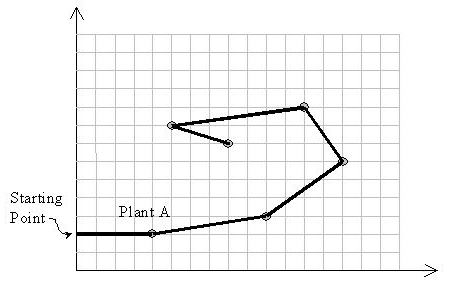poj 1696(极角排序)
| Time Limit: 1000MS | Memory Limit: 10000K | |
| Total Submissions: 3924 | Accepted: 2457 |
Description
- It can not turn right due to its special body structure.
- It leaves a red path while walking.
- It hates to pass over a previously red colored path, and never does that.
The pictures transmitted by the Discovery space ship depicts that
plants in the Y1999 grow in special points on the planet. Analysis of
several thousands of the pictures have resulted in discovering a magic
coordinate system governing the grow points of the plants. In this
coordinate system with x and y axes, no two plants share the same x or y.
An M11 needs to eat exactly one plant in each day to stay alive.
When it eats one plant, it remains there for the rest of the day with no
move. Next day, it looks for another plant to go there and eat it. If
it can not reach any other plant it dies by the end of the day. Notice
that it can reach a plant in any distance.
The problem is to find a path for an M11 to let it live longest.
Input is a set of (x, y) coordinates of plants. Suppose A with the
coordinates (xA, yA) is the plant with the least y-coordinate. M11
starts from point (0,yA) heading towards plant A. Notice that the
solution path should not cross itself and all of the turns should be
counter-clockwise. Also note that the solution may visit more than two
plants located on a same straight line.

Input
first line of the input is M, the number of test cases to be solved (1
<= M <= 10). For each test case, the first line is N, the number
of plants in that test case (1 <= N <= 50), followed by N lines
for each plant data. Each plant data consists of three integers: the
first number is the unique plant index (1..N), followed by two positive
integers x and y representing the coordinates of the plant. Plants are
sorted by the increasing order on their indices in the input file.
Suppose that the values of coordinates are at most 100.
Output
should have one separate line for the solution of each test case. A
solution is the number of plants on the solution path, followed by the
indices of visiting plants in the path in the order of their visits.
Sample Input
2
10
1 4 5
2 9 8
3 5 9
4 1 7
5 3 2
6 6 3
7 10 10
8 8 1
9 2 4
10 7 6
14
1 6 11
2 11 9
3 8 7
4 12 8
5 9 20
6 3 2
7 1 6
8 2 13
9 15 1
10 14 17
11 13 19
12 5 18
13 7 3
14 10 16
Sample Output
10 8 7 3 4 9 5 6 2 1 10
14 9 10 11 5 12 8 7 6 13 4 14 1 3 2
题意:一只蚂蚁走一个点集,每次只能往左走。。问最长能走的路。。
题解:我开始想到死胡同了,想用Graham解。。解不出来,,然后在网上找的解法。不停地排序排序。
http://www.cnblogs.com/ACMan/archive/2012/08/17/2644644.html大概就是这个过程。。
///判断线段与矩形是否相交
#include<stdio.h>
#include<iostream>
#include<string.h>
#include<math.h>
#include<algorithm>
using namespace std;
const double eps = 1e-;
const int N = ;
struct Point
{
int idx,x,y;
} p[N];
Point result[N];
int n,pos;
int cross(Point a,Point b,Point c)
{
return (a.x-c.x)*(b.y-c.y)-(a.y-c.y)*(b.x-c.x);
}
int dis(Point a,Point b)
{
return (a.x-b.x)*(a.x-b.x)+(a.y-b.y)*(a.y-b.y);
}
int cmp(Point a,Point b)
{
if(cross(a,b,p[pos])>) return ;
if(cross(a,b,p[pos])==&&dis(b,p[pos])>dis(a,p[pos])) return ;
return ;
} int main()
{
int tcase;
scanf("%d",&tcase);
while(tcase--)
{
scanf("%d",&n);
for(int i=; i<n; i++)
{
scanf("%d%d%d",&p[i].idx,&p[i].x,&p[i].y);
if( p[i].y < p[].y || (p[i].y == p[].y && p[i].x < p[].x) )
swap(p[],p[i]);
}
pos = ;
int j = ;
sort(p+,p+n,cmp);
result[j++] = p[pos++];
for (int i = ; i < n; i++)
{
sort(p + pos, p + n, cmp);
result[j++] = p[pos++];
}
result[j++] = p[pos++];
printf("%d", j);
for (int i = ; i < j; i++)
{
printf(" %d", result[i].idx);
}
printf("\n");
}
return ;
}
最新文章
- Redis Geo: Redis新增位置查询功能
- 第15章 设备无关位图_15.1 DIB文件格式
- ABAP自定义类的构造方法
- Makefile中=、:=、+=、?=的区别
- 关于环信的WebIm的SDK一些使用注意
- SMP和MAPP的区别
- MD3200扩展柜MD1200,玩起
- 深入探索C++对象模型-语义
- Java反射机制示例
- 2017ecjtu-summer training #11 POJ 1018
- 自定义android 4.0以上的对话框风格
- mybatis 异常Result Maps collection does not contain value for java.lang.String
- 【JavaScript】封装实用方法【持续积累】
- 博弈论入门之nim游戏
- glide使用
- linux内核中的最简单的输入输出调度算法noop
- FFmpeg中几个结构体的意义
- Java 常用的几个lambda表达式
- 通过GeneXus如何快速构建微服务架构
- enumerate的简单使用